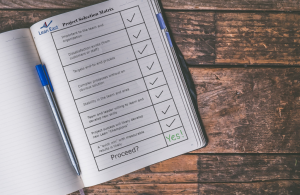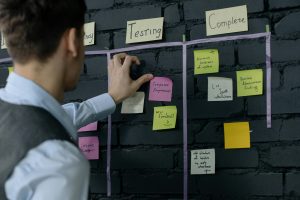
All of us make mistakes. Harvard Business School Professor Amy Edmondson encourages us to learn the difference between the mistakes that hurt us and the mistakes that help us. She wrote, Right Kind of Wrong: The Science of Failing Well in 2023, and the book has already won several “best book” awards. To err is human, but not all failures are alike. Learn why context matters, the science behind how we respond to failure, and why intelligent failures are good.
Not All Failure is Alike
Nobody is excited about failure, but not every error or mistake is the same — context matters. Edmondson shares three types of failures that differ based on the situation.
Failures in straightforward, basic, repeatable processes are consistent context failures and the most inexcusable kind. Scientific experiments and other failures in new, uncertain conditions lead to knowledge and are what Edmondson terms, novel context failures. In between the consistent and the novel contexts are variable context failures. These are situations where we have extensive prior knowledge but still face meaningful uncertainty. We describe each of these failure types and also provide examples of each below.
Consistent Context Failures
Basic errors occur in well-developed processes with limited variability. Typically, there is a single cause for the failure and humans are often to blame. Examples of consistent context failures are adding too much of an ingredient in a recipe, a wrong part in a vehicle assembly line, or a laboratory technician mislabeling a sample.
Here are the typical failure modes for consistent context failures:
- Inattention
- Neglect
- Overconfidence
- Faulty assumptions
- Lack of training
Lean East helps clients complete Lean Six Sigma improvement projects that make the process more consistent while removing as much of the waste and uncertainty as we can. Working in a consistent context, well-developed processes often offer the most opportunity for applying improvement tools. Here are five ways we improve the quality of consistent processes:

- Standardize the process and then remove steps from the process
- Make the workplace more visual and obvious
- Use checklists
- Improve the culture for reporting issues
- Mistake proofing (poka-yoke)
Variable Context Failures
Complex failures occur in variable context situations when an out-of-the-ordinary situation presents itself. Examples include driving your car in an unknown area during a snow blizzard, a patient presenting with unusual symptoms in an emergency room, a data issue after a software system upgrade, or a pilot flying through an unexpected storm.
Edmondson notes that “none of us can master every aspect of the relevant knowledge” in a complex, variable context. She suggests three simple practices:
- Framing. Begin by acknowledging the complexity of the situation you are dealing with. Recognize that the risk for errors is high, so you can concentrate on the matter and get help from others.
- Amplify. Human tendency is to downplay or ignore the increased risk. Be sure to express the risk of the situation to others. Explain that the roads are bad and you need to focus. Tell your team that this is an unknown situation and will require them to speak up if they see an issue.
- Practicing. Finally, be as prepared as possible for the complex problem. Aircraft simulators, fire drills, rapid response teams, and active shooter drills are ways to rehearse a complex situation in advance so that you are better prepared.
Novel Context Failures

Some failures occur in contexts where the existing state of knowledge is limited. For example, in a scientific laboratory studying a new enzyme, a startup business using a new technology, or an oncologist trying a new cancer treatment for a patient.
Novel contexts are typically at the forefront of a body of knowledge or a system. The result of the situation is unknown, and failure is often a more likely outcome than success. When you are working in a novel context you should strive to have any failure be an “intelligent failure.”
Intelligent Failures
When you are working in a novel context, failure can actually be a good thing. Edmonson terms intelligent failures as ones that are the right kind of wrong (her book title), and required in order to achieve success in a new territory or novel context.
Here are the four key attributes of an intelligent failure:
- It takes place in a new territory or novel context.
- The failure is a hypothesis-driven experiment informed by available knowledge.
- The failure is as small as possible while still providing valuable insights.
- Lessons learned from failures guide the next steps.
I like this definition of an intelligent failure and also find it to be consistent with an experiment one would undertake in a lean innovation opportunity.

I always encourage leaders to use lean startup thinking and design their experiment(s) as inexpensively and simply as possible. For example, if you have an idea for a simple software solution, don’t design the solution, build it, and then check to see who wants to buy it. Instead, begin by creating an advertisement for the solution and buying ads. If many potential customers see your advertisement and click to sign up for the solution (even though it doesn’t exist yet) then you know there is demand. Build it and sell it to those who signed up to be early adopters. If people see the ad and enough people do not sign up, STOP! You can skip the hard work of building the product as your simple (and also very inexpensive) experiment shows that you won’t have enough customers anyway!
Our Response to a Mistake is Based on Brain Chemistry
Unfortunately, our brain defaults to treating all failure types the same. The amygdala is the part of the brain responsible for this reaction. When a person feels stressed or afraid because they made a mistake, the amygdala releases stress hormones that prepare the body to fight the threat or flee from the danger. The default response is to have this response whether the error is a consistent context mistake or a novel context intelligent lesson!
Edmondson encourages us to learn from her book and fight our brain’s default response. Realize that an intelligent failure isn’t really a mistake and nothing to be stressed about. Treat every intelligent failure as “just one more way that you now know doesn’t work.”
Improving Your Quality

The Lean East mission is to bring out the best in organizations by bringing out the best in the people. You may be amazed to learn that some of the organizations with the poorest quality results don’t even know it! They either aren’t measuring their quality properly, or their employees aren’t being honest when they share their results.
Lean East is making plans in 2024 to help our existing and new clients improve their quality and reduce failures through quality control and quality improvement methods. We will also continue to support improved employee cultures, so employees are involved in the solutions and trust levels are high so your quality results are real and not fabricated.
Quality Control, Quality Improvement, Quality Culture
Quality Control
Quality control (QC) consists of your set of procedures intended to ensure that a manufactured product or performed service meets the requirements of the client or customer. You must measure the right things in the right way. We will share more about quality control methodologies in an upcoming post.
Quality Improvement
Lean East teaches Lean Six Sigma methods that help you identify and resolve your root cause issues. The goal of every leader should be to practice the ideas above and then move their work from a novel context to a consistent, well-controlled, context.
Quality Culture

Some organizational cultures have other issues with providing high-quality outcomes. We have worked with organizations that have very poorly developed and controlled processes. Employees struggle to get their job done and have to depend upon their own skills and knowledge rather than the system and process design. We often call these employees, “super nurses” since they are expected to have heroic abilities!
We have also worked with organizations that do not allow for the time or resources required for quality improvement to address root causes or don’t have resources available to support quality improvement. They can contact Lean East for a quality system assessment and support with making improvements. The cost of poor quality is tremendous!
Finally, in some organizations, it is safer and smarter to not report your issue. Leaders in these organizations punish mistakes, which results in quality (or sometimes safety) issues not being reported! These organizations get the sense that everything is going well until they eventually learn the truth after employee complaints or even product recalls.
Summary
Please leave comments and questions about failure modes and quality below. Also, reach out to us if you have quality expertise or need quality assessment or improvement services in the Northeast.


Related Posts
The Continuing Evolution of the Employee Using AI
10 Great Leadership Lessons from Elon Musk II
10 Great Leadership Lessons from Elon Musk